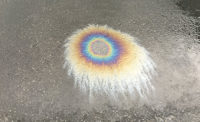Tens of millions of gallons of oil enter our oceans each year, but a mere 8 percent is due to tanker or pipeline spills.1 The other 92 percent of “invisible oil pollution” tend to go a bit more unnoticed.
The National Ocean Service reports that contaminants enter the environment from a variety of sources2, such as industrial and commercial facilities; non-point-sources like roads, parking lots, and storm drains; and wastewater treatment plants and sewage systems, in addition to the spills that you see on the news. Even perfectly functioning equipment has a tendency to leak oil.
Reduce environmental impact
EPA “looks at the small-oil-spill problem as a death by a thousand cuts.”3 Thirty-five years of experience in the environmental field has opened our eyes to an all-too-frequent, but easy-to-address issue: 80 percent of all oil spills happen on land4 due to vehicle or equipment failures. These spills almost always happen when they are least expected. And they tend to happen to individuals usually ill-equipped and/or under-trained to handle the spill.
These tips can prevent more extensive spreading and environmental damage until trained spill control professionals arrive:
- Train employees to use proper spill prevention practices when working with oil sources.
- Personal protective equipment (PPE) should be provided to ensure safe handling of materials.
- Have a visible worksite map that identifies the location of oil and fuel sources.
- Employees should know in advance which spill situations they can safely contain and which spills are unsafe to handle.
- Along with storage instructions and supervision, give workers product recommendations -- spill pads, rugs, and booms.
- Oil spills spread 100 times faster in wet weather than dry; you may want to have specialty spill control materials that work in wet conditions.
Actions for on site
- Time is valuable, but don’t panic. Rely on training to stay calm and move efficiently.
- Assess the site risks and hazards present.
- Follow your company’s spill control procedures to notify relevant parties -- internal environmental coordinators, spill contractors, emergency responders, EPA, state and local environmental authorities, etc.
- With help on the way, and once fully equipped with proper PPE, begin to contain the spill to keep it from spreading until help arrives.
- If safe, and possible, try to plug the source of the leak.
- If that’s not an option, surround or contain the spill directly at the source to keep it from spreading.
- If it is not possible to surround/contain the spill, it’s time for damage control. Identify high -risk areas like storm drains, waterways, and soil.
-
Dell’Amore, Christine and Nunez, Christina. 3 Surprising Sources of Oil Pollution in the Ocean. National Geographic. March 25, 2014. <https://news.nationalgeographic.com/news/2014/03/140325-texas-pollution-oil-spills-animals-science/>. January 5, 2018. - Contaminants in the Environment. National Ocean Service: National Oceanic and Atmospheric Administration, U.S. Department of Commerce. <https://oceanservice.noaa.gov/observations/contam/>. January 5, 2018.
- Dell’Amore, Christine and Nunez, Christina. 3 Surprising Sources of Oil Pollution in the Ocean. National Geographic. March 25, 2014. <https://news.nationalgeographic.com/news/2014/03/140325-texas-pollution-oil-spills-animals-science/>. January 5, 2018.
- Oil Spill Cleanup Veterans Join Forces. Industrial Supply. June 7, 2016. <http://industrialsupplymagazine.com/pages/News-060716-Oil-spill-cleanup-veterans-join-forces.php>. January 5, 2018.

